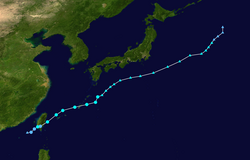| Timeline of the 2018 Pacific typhoon season | |
|---|---|
 Season summary map | |
| Season boundaries | |
| First system formed | December 29, 2017 |
| Last system dissipated | December 29, 2018 [nb 1] |
| Strongest system | |
| Name | Kong-rey & Yutu |
| Maximum winds | 215 km/h (130 mph) (10-minute sustained) |
| Lowest pressure | 900 hPa (mbar) |
| Longest lasting system | |
| Name | Usagi |
| Duration | 14 days |
The 2018 Pacific typhoon season was formerly the costliest Pacific typhoon season on record before being surpassed the following year and 2023. The season had no official boundaries, and storms can form year-round. Despite this, activity usually peaks between May and November. The season featured above-average activity, with 29 named storms, 13 typhoons, and 7 super typhoons forming in the West Pacific. [2] [4] [nb 2] The season's first named storm, Bolaven, developed on January 3, while the season's last named storm, Man-yi, dissipated on November 28. The season's first typhoon, Jelawat, reached typhoon status on March 29, eventually becoming also the first super typhoon the next day.
Contents
- Timeline
- January
- February
- March
- April
- May
- June
- July
- August
- September
- October
- November
- December
- Notes
- References
This timeline documents all of the events of the 2018 Pacific typhoon season. Most of the tropical cyclones form between May and November. The scope of this article is limited to the Pacific Ocean, north of the equator between 100°E and the International Date Line. The Japan Meteorological Agency (JMA) is the official Regional Specialized Meteorological Centre for the Western Pacific Basin. As such, it is responsible for assigning names to all tropical cyclones that reach 10-minute maximum sustained winds of at least 65 kilometres per hour (40 mph) in the region. [6] The Joint Typhoon Warning Center (JTWC) also monitors systems in the Western Pacific Basin, assigning systems a number with a "W" suffix if the system is a tropical depression or stronger. PAGASA also assigns local names to tropical depressions or stronger which form within or enter their area of responsibility, regardless if the JMA has assigned the cyclone a name; however, these names are not in common use outside of PAGASA's area of responsibility. [7] In this season, 21 systems entered or formed in the Philippine Area of Responsibility (PAR), of which 7 of them made landfall over the Philippines.














